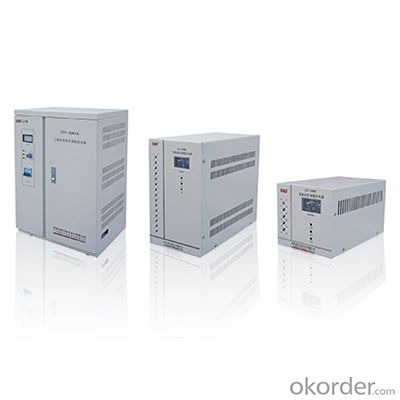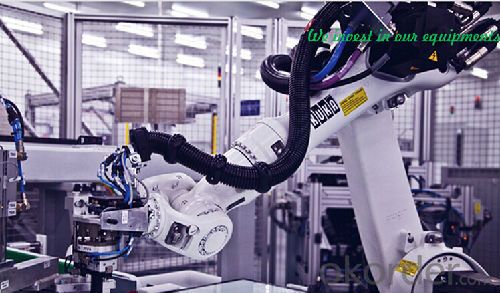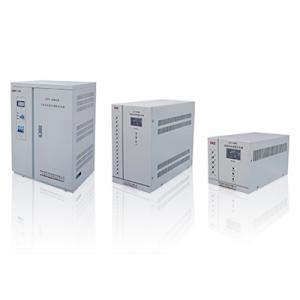0.5-30KVA Power Inverter with Charger Fully Automatic AC Stabilized Power Supply
- Loading Port:
- China main port
- Payment Terms:
- TT or LC
- Min Order Qty:
- 1 pc
- Supply Capability:
- 1000 pc/month
OKorder Service Pledge
OKorder Financial Service
You Might Also Like
ZTY series high accuracy fully automatic AC stabilized Power Supply is a key series of our stabilizing products. It mainly consists of auto-transformer, servo motor, automatic control circuit. When the utility is not stable or the load fluctuates, the automatic control circuit modifies the control output according to the input voltage change of power supply, with driving the servo motor, and then the servo motor adjusting the carbon brush of auto-transformer to regulate the output voltage at its rating and remain stable.
Single Phase | |||||||||
VA Rating | 0.5KVA | 1KVA | 2KVA | 3KVA | 5KVA | 10KVA | 15KVA | 20KVA | 30KVA |
INPUT | |||||||||
Phase | Single Phase+N+GND | ||||||||
Voltage Range | 160Vac-250Vac | ||||||||
OUTPUT | |||||||||
Voltage | 220V | ||||||||
Voltage Precision | ≤±3% | ||||||||
Frequency | 50/60Hz | ||||||||
Over-Voltage Protection | Output Voltage 250V±5V | ||||||||
Low-Voltage Protection | Output Voltage 183V±5V | ||||||||
Efficiency | ≥96% | ||||||||
OTHERS | |||||||||
Display Mode | LED / METER | ||||||||
Input/Output Device | Optional Plug; Socket / Terminal | ||||||||
Waveform Distortion | No affixation Waveform Distortion | ||||||||
Response Time | (±10% Varies) <1s | ||||||||
Insulation Resistance | ≥2MΩ | ||||||||
Anti-Electricy Intension | Low frequency sine voltage 1500V take 1 minute no rout and camber phenomena | ||||||||
Ambient Temperature | 0℃-40℃ | ||||||||
Relative Humidity | ≤95% | ||||||||
Working | Continue | ||||||||
Dimension(WxDxH)mm | 150x247x144 | 150x247x200 | 150x285x260 | 175x360x305 | 220x485x430 | 330x370x612 | 530x400x732 | ||
Net Weight(kg) | 4.3 | 4.8 | 8.2 | 9.5 | 15.2 | 31 | 53 | 59 | 91 |
Packing(WxDxH)mm | 235x360x235 | 235x360x290 | 230x395x350 | 278x470x415 | 280x555x495 | 430x500x690 | 635x500x830 | ||
Gross Weight(kg) | 4.8 | 5.3 | 8.8 | 10.1 | 15.9 | 32 | 56 | 61.3 | 94.5 |
MODEL | ZTY Three Phase | |||||
VA Rating | 3KVA | 6KVA | 10KVA | 15KVA | 20KVA | 30KVA |
INPUT | ||||||
Phase | Three Phase+N+GND | |||||
Voltage Range | Line Voltage 277Vac-433Vac | |||||
OUTPUT | ||||||
Voltage | 380V | |||||
Voltage Precision | ≤±3% | |||||
Frequency | 50/60Hz | |||||
Over-Voltage Protection | Output Voltage 250V±5V | |||||
Low-Voltage Protection | Output Voltage 183V±5V | |||||
Efficiency | ≥96% | |||||
OTHERS | ||||||
Display Model | LED / METER | |||||
Input/Output Device | Terminal | |||||
Waveform Distortion | No Affixation Waveform Distortion | |||||
Response Time | (±10% Varies) <1s | |||||
Insulation Resistance | ≥2MΩ | |||||
Anti-Electricy Intension | Low Frequency Sine Voltage 1500V Take 1 minute No Rout and Camber phenomena | |||||
Ambient Temperature | 0℃-40℃ | |||||
Relative Humidity | ≤95% | |||||
Working | Continue | |||||
Dimension(WxDxH)mm | 200x480x395 | 330x350x702 | 330x380x752 | 530x400x732 | ||
Net Weight(kg) | 14.5 | 35 | 37 | 51 | 58 | 95 |
Packing(WxDxH)mm | 260x555x505 | 460x435x790 | 555x420x840 | 635x500x830 | ||
Gross Weight(kg) | 16.8 | 37.6 | 40 | 54.2 | 61.6 | 105 |
· Q. What is an UPS and What it is for ?
An uninterruptible power supply (UPS) is a device that allows your computer or telephone switch or critical equipement to keep running for at least a short time or longer time when the primary power source is lost. It also provides protection from power surges, spikes, brownouts, interference and other unwanted problems on the supported equipment.
· Q. How long the UPS to run when power goes?
This can take 3 paths.
1.You can pick a UPS that is rated for pretty much the full VA you need so it will be running at 100% of capability and will thus last 'n' minutes.
2.You can pick a UPS that is rated at a much higher VA value than you really need so, for example, is running at 50% of capability and will thus last for longer than the UPS from option 1.
3.You can use extra external battery packs to run for longer. If charging capability allows, the more and the bigger batteries you take with, the longer time UPS runs.
or using a generator after about 6 hours, it will be more cost-effective, with a short runtime UPS to bridge the generator start-up gap.



- Q:Are there any noise or vibration concerns associated with solar inverters?
- Yes, there can be noise and vibration concerns associated with solar inverters. However, the extent of these concerns will vary depending on the specific make and model of the inverter. Some inverters may produce a low humming or buzzing noise during operation, which is generally considered normal. However, if the noise becomes excessively loud or disruptive, it may indicate a malfunctioning or poorly installed inverter. Similarly, vibrations can occur in solar inverters, especially if they are not properly secured or mounted. These vibrations can potentially cause additional noise or even lead to damage if left unaddressed. Proper installation and maintenance practices, such as securely fastening the inverter and regularly inspecting for any signs of loose components or abnormal vibrations, can help mitigate these concerns. It is important to note that advancements in technology have led to the development of quieter and more efficient solar inverters. When selecting an inverter for a solar system, it is advisable to research and choose a reputable brand that has a track record of producing inverters with minimal noise and vibration issues. Additionally, consulting with a professional solar installer can provide valuable insights and recommendations to ensure a smooth and quiet operation of the solar inverter.
- Q:How does a solar inverter handle sudden changes in solar irradiance?
- A solar inverter handles sudden changes in solar irradiance by continuously monitoring the incoming solar energy and adjusting its output accordingly. When there is a sudden increase in solar irradiance, the inverter quickly ramps up its power output to match the new level of energy being generated. Similarly, if there is a sudden decrease in solar irradiance, the inverter rapidly decreases its output to prevent overloading. This dynamic response ensures optimal power generation and protects the system from potential damage due to irregular fluctuations in solar irradiance.
- Q:How do you calculate the total power capacity for a solar inverter?
- To calculate the total power capacity for a solar inverter, you need to consider the maximum power output of the solar panels connected to it. The total power capacity of the inverter should be equal to or greater than the total maximum power output of all the solar panels combined. This ensures that the inverter can handle the maximum power generated by the solar panels and efficiently convert it into usable electricity.
- Q:Can a solar inverter be connected to a backup battery system?
- Yes, a solar inverter can be connected to a backup battery system. This allows the solar energy generated during the day to be stored in the backup batteries and used during times when there is no sunlight or during power outages.
- Q:Can a solar inverter be used with different solar panel types?
- Yes, a solar inverter can generally be used with different solar panel types as long as the electrical specifications of the panels are compatible with the inverter. However, it is important to ensure that the voltage, current, and power ratings of the panels are within the acceptable range for the specific inverter model to ensure optimal performance and safety.
- Q:Can a solar inverter be used in a solar-powered telecommunications system?
- Yes, a solar inverter can be used in a solar-powered telecommunications system. A solar inverter is an essential component in such systems as it converts the DC (direct current) electricity generated by the solar panels into AC (alternating current) electricity, making it compatible with the telecommunication devices and equipment.
- Q:How does the size of a solar inverter affect its performance?
- The size of a solar inverter directly impacts its performance. A larger inverter with a higher wattage capacity can handle a greater amount of solar power generated by the panels. On the other hand, a smaller inverter may not be able to efficiently convert and utilize all the energy produced, resulting in a decrease in overall system performance. Therefore, choosing the appropriate size solar inverter is crucial to ensure optimal performance and maximize energy production.
- Q:What is the role of a solar inverter in a net metering system?
- The role of a solar inverter in a net metering system is to convert the direct current (DC) electricity generated by solar panels into alternating current (AC) electricity that can be used by the grid or consumed in the building. It also ensures that any excess electricity produced by the solar panels is fed back into the grid, allowing the system owner to receive credits or compensation for the surplus energy.
- Q:Can a solar inverter be used with a solar-powered pool heating system?
- Yes, a solar inverter can be used with a solar-powered pool heating system. The solar inverter is responsible for converting the direct current (DC) generated by the solar panels into alternating current (AC) that can be used to power various devices, including pool heating systems.
- Q:Can a solar inverter be used in a floating solar system?
- Yes, a solar inverter can be used in a floating solar system. In fact, a solar inverter is an essential component of any solar power system, including floating solar systems. The purpose of a solar inverter is to convert the direct current (DC) electricity produced by the solar panels into alternating current (AC) electricity that can be used to power electrical appliances or be fed into the grid. Whether the solar panels are installed on the ground, on rooftops, or on a floating platform, a solar inverter is necessary to ensure the efficient and safe conversion of solar energy into usable electricity.
1. Manufacturer Overview |
|
|---|---|
| Location | |
| Year Established | |
| Annual Output Value | |
| Main Markets | |
| Company Certifications | |
2. Manufacturer Certificates |
|
|---|---|
| a) Certification Name | |
| Range | |
| Reference | |
| Validity Period | |
3. Manufacturer Capability |
|
|---|---|
| a)Trade Capacity | |
| Nearest Port | |
| Export Percentage | |
| No.of Employees in Trade Department | |
| Language Spoken: | |
| b)Factory Information | |
| Factory Size: | |
| No. of Production Lines | |
| Contract Manufacturing | |
| Product Price Range | |
Send your message to us
0.5-30KVA Power Inverter with Charger Fully Automatic AC Stabilized Power Supply
- Loading Port:
- China main port
- Payment Terms:
- TT or LC
- Min Order Qty:
- 1 pc
- Supply Capability:
- 1000 pc/month
OKorder Service Pledge
OKorder Financial Service
Similar products
New products
Hot products
Hot Searches
Related keywords
































